ICP(迭代最近点)算法
图像配准是图像处理研究领域中的一个典型问题和技术难点,其目的在于比较或融合针对同一对象在不同条件下获取的图像,例如图像会来自不同的采集设备,取自不同的时间,不同的拍摄视角等等,有时也需要用到针对不同对象的图像配准问题。具体地说,对于一组图像数据集中的两幅图像,通过寻找一种空间变换把一幅图像映射到另一幅图像,使得两图中对应于空间同一位置的点一一对应起来,从而达到信息融合的目的。 一个经典的应用是场景的重建,比如说一张茶几上摆了很多杯具,用深度摄像机进行场景的扫描,通常不可能通过一次采集就将场景中的物体全部扫描完成,只能是获取场景不同角度的点云,然后将这些点云融合在一起,获得一个完整的场景。
ICP(Iterative Closest Point迭代最近点)算法是一种点集对点集配准方法。如下图所示,PR(红色点云)和RB(蓝色点云)是两个点集,该算法就是计算怎么把PB平移旋转,使PB和PR尽量重叠。
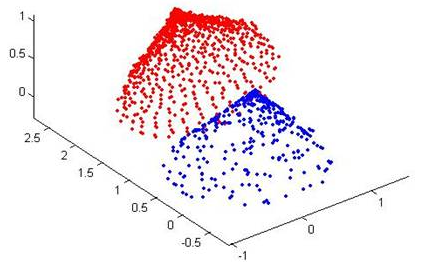
用数学语言描述如下,即ICP算法的实质是基于最小二乘法的最优匹配,它重复进行“确定对应关系的点集→计算最优刚体变换”的过程,直到某个表示正确匹配的收敛准则得到满足。
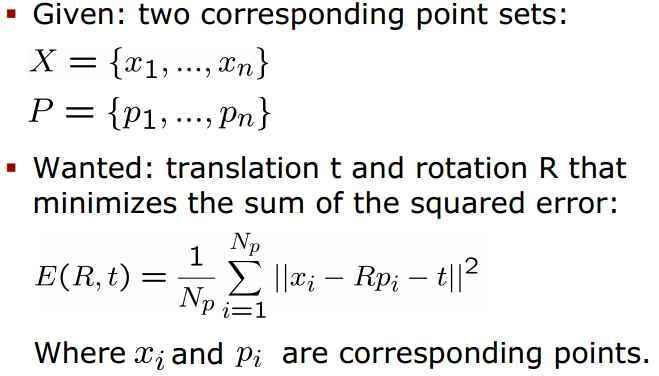
ICP算法基本思想:
如果知道正确的点对应,那么两个点集之间的相对变换(旋转、平移)就可以求得封闭解。
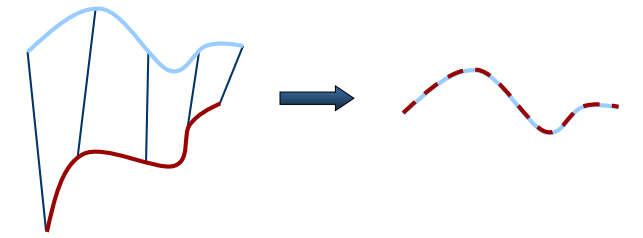
首先计算两个点集X和P的质心,分别为μx和μp

然后在两个点集中分别减去对应的质心(Subtract the corresponding center of mass from every point in the two point sets before calculating the transformation)

目标函数E(R,t)的优化是ICP算法的最后一个阶段。在求得目标函数后,采用什么样的方法来使其收敛到最小,也是一个比较重要的问题。求解方法有基于奇异值分解的方法、四元数方法等。
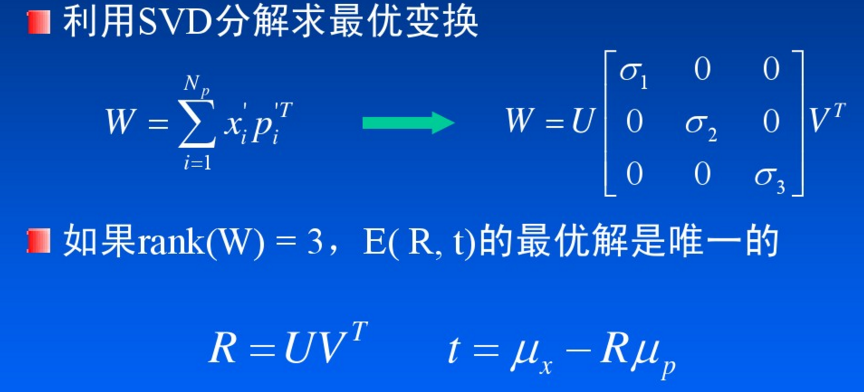
如果初始点“足够近”,可以保证收敛性
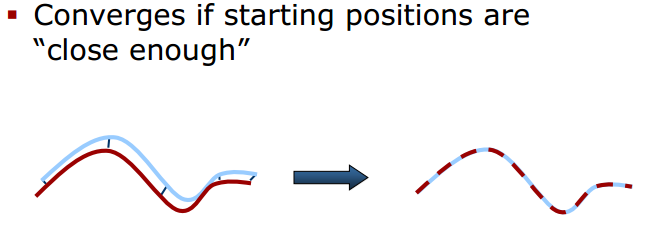
ICP算法优点:
- 可以获得非常精确的配准效果
- 不必对处理的点集进行分割和特征提取
- 在较好的初值情况下,可以得到很好的算法收敛性
ICP算法的不足之处:
- 在搜索对应点的过程中,计算量非常大,这是传统ICP算法的瓶颈
- 标准ICP算法中寻找对应点时,认为欧氏距离最近的点就是对应点。这种假设有不合理之处,会产生一定数量的错误对应点
针对标准ICP算法的不足之处,许多研究者提出ICP算法的各种改进版本,主要涉及如下所示的6个方面。

标准ICP算法中,选用点集中所有的点来计算对应点,通常用于配准的点集元素数量都是非常巨大的,通过这些点集来计算,所消耗的时间很长。在后来的研究中,提出了各种方法来选择配准元素,这些方法的主要目的都是为了减小点集元素的数目,即如何选用最少的点来表征原始点集的全部特征信息。在点集选取时可以:1.选取所有点;2.均匀采样(Uniform sub-sampling );3.随机采样(Random sampling);4.按特征采样(Feature based Sampling );5.法向空间均匀采样(Normal-space sampling),如下图所示,法向采样保证了法向上的连续性(Ensure that samples have normals distributed as uniformly as possible)

基于特征的采样使用一些具有明显特征的点集来进行配准,大量减少了对应点的数目。
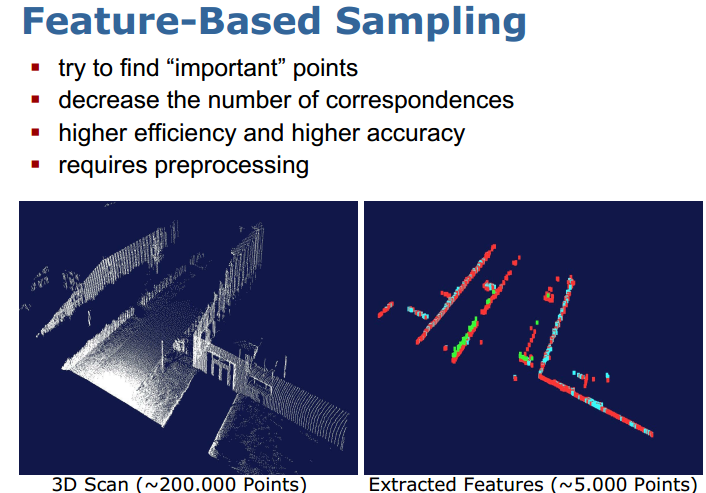
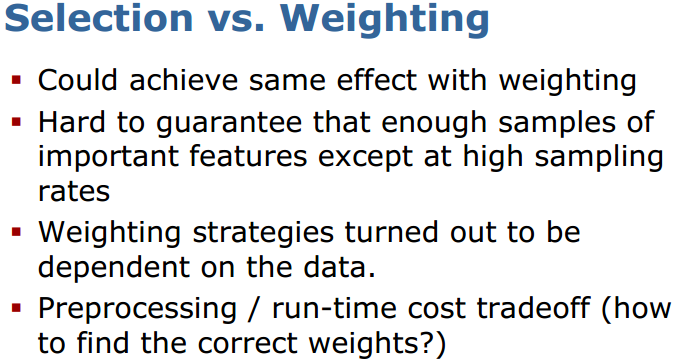
点集匹配上有:最近邻点(Closet Point)
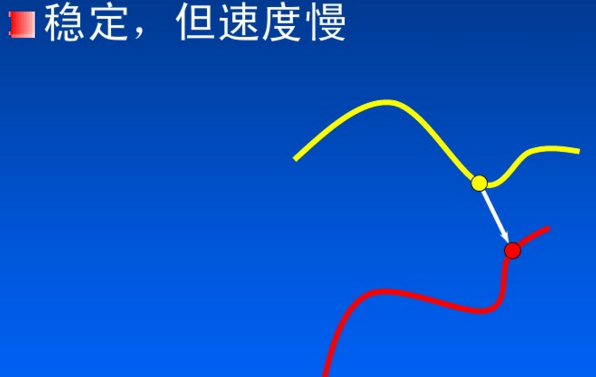 法方向最近邻点(Normal Shooting)
法方向最近邻点(Normal Shooting)
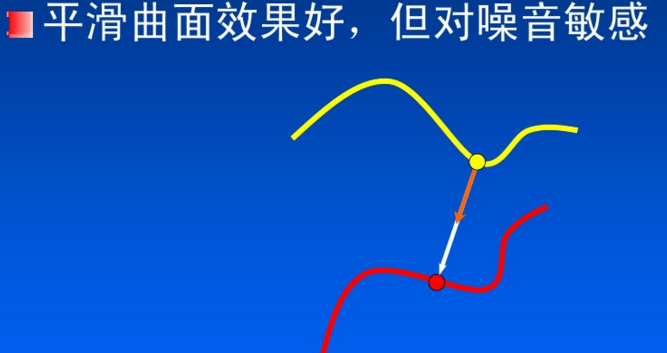
投影法(Projection)
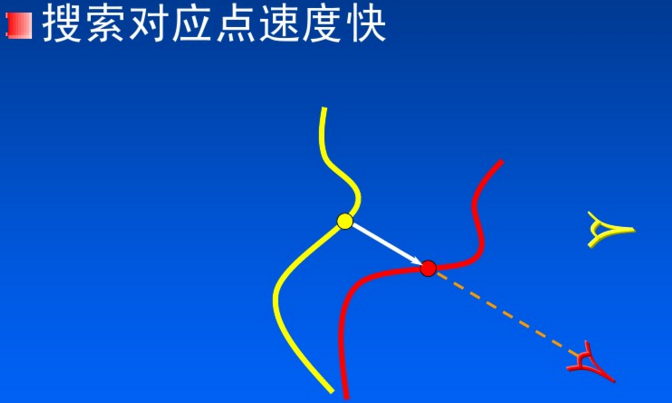
根据之前算法的描述,下面使用Python来实现基本的ICP算法(代码参考了这里):
import numpy as np def best_fit_transform(A, B):
'''
Calculates the least-squares best-fit transform between corresponding 3D points A->B
Input:
A: Nx3 numpy array of corresponding 3D points
B: Nx3 numpy array of corresponding 3D points
Returns:
T: 4x4 homogeneous transformation matrix
R: 3x3 rotation matrix
t: 3x1 column vector
''' assert len(A) == len(B) # translate points to their centroids
centroid_A = np.mean(A, axis=0)
centroid_B = np.mean(B, axis=0)
AA = A - centroid_A
BB = B - centroid_B # rotation matrix
W = np.dot(BB.T, AA)
U, s, VT = np.linalg.svd(W)
R = np.dot(U, VT) # special reflection case
if np.linalg.det(R) < 0:
VT[2,:] *= -1
R = np.dot(U, VT) # translation
t = centroid_B.T - np.dot(R,centroid_A.T) # homogeneous transformation
T = np.identity(4)
T[0:3, 0:3] = R
T[0:3, 3] = t return T, R, t def nearest_neighbor(src, dst):
'''
Find the nearest (Euclidean) neighbor in dst for each point in src
Input:
src: Nx3 array of points
dst: Nx3 array of points
Output:
distances: Euclidean distances (errors) of the nearest neighbor
indecies: dst indecies of the nearest neighbor
''' indecies = np.zeros(src.shape[0], dtype=np.int)
distances = np.zeros(src.shape[0])
for i, s in enumerate(src):
min_dist = np.inf
for j, d in enumerate(dst):
dist = np.linalg.norm(s-d)
if dist < min_dist:
min_dist = dist
indecies[i] = j
distances[i] = dist
return distances, indecies def icp(A, B, init_pose=None, max_iterations=50, tolerance=0.001):
'''
The Iterative Closest Point method
Input:
A: Nx3 numpy array of source 3D points
B: Nx3 numpy array of destination 3D point
init_pose: 4x4 homogeneous transformation
max_iterations: exit algorithm after max_iterations
tolerance: convergence criteria
Output:
T: final homogeneous transformation
distances: Euclidean distances (errors) of the nearest neighbor
''' # make points homogeneous, copy them so as to maintain the originals
src = np.ones((4,A.shape[0]))
dst = np.ones((4,B.shape[0]))
src[0:3,:] = np.copy(A.T)
dst[0:3,:] = np.copy(B.T) # apply the initial pose estimation
if init_pose is not None:
src = np.dot(init_pose, src) prev_error = 0 for i in range(max_iterations):
# find the nearest neighbours between the current source and destination points
distances, indices = nearest_neighbor(src[0:3,:].T, dst[0:3,:].T) # compute the transformation between the current source and nearest destination points
T,_,_ = best_fit_transform(src[0:3,:].T, dst[0:3,indices].T) # update the current source
# refer to "Introduction to Robotics" Chapter2 P28. Spatial description and transformations
src = np.dot(T, src) # check error
mean_error = np.sum(distances) / distances.size
if abs(prev_error-mean_error) < tolerance:
break
prev_error = mean_error # calculcate final tranformation
T,_,_ = best_fit_transform(A, src[0:3,:].T) return T, distances if __name__ == "__main__":
A = np.random.randint(0,101,(20,3)) # 20 points for test rotz = lambda theta: np.array([[np.cos(theta),-np.sin(theta),0],
[np.sin(theta),np.cos(theta),0],
[0,0,1]])
trans = np.array([2.12,-0.2,1.3])
B = A.dot(rotz(np.pi/4).T) + trans T, distances = icp(A, B) np.set_printoptions(precision=3,suppress=True)
print T
上面代码创建一个源点集A(在0-100的整数范围内随机生成20个3维数据点),然后将A绕Z轴旋转45°并沿XYZ轴分别移动一小段距离,得到点集B。结果如下,可以看出ICP算法正确的计算出了变换矩阵。

需要注意几点:
1.首先需要明确公式里的变换是T(P→X), 即通过旋转和平移把点集P变换到X。我们这里求的变换是T(A→B),要搞清楚对应关系。
2.本例只用了20个点进行测试,ICP算法在求最近邻点的过程中需要计算20×20次距离并比较大小。如果点的数目巨大,那算法的效率将非常低。
3.两个点集的初始相对位置对算法的收敛性有一定影响,最好在“足够近”的条件下进行ICP配准。
参考:
Iterative Closest Point (ICP) and other matching algorithms
http://www.mrpt.org/Iterative_Closest_Point_%28ICP%29_and_other_matching_algorithms
PCL学习笔记二:Registration (ICP算法)
http://www.voidcn.com/blog/u010696366/article/p-3712120.html
https://github.com/ClayFlannigan/icp/blob/master/icp.py
ICP迭代最近点算法综述
ICP(迭代最近点)算法的更多相关文章
- ICP算法(Iterative Closest Point迭代最近点算法)
标签: 图像匹配ICP算法机器视觉 2015-12-01 21:09 2217人阅读 评论(0) 收藏 举报 分类: Computer Vision(27) 版权声明:本文为博主原创文章,未经博主允许 ...
- 【转】ICP算法(Iterative Closest Point迭代最近点算法)
原文网址:https://www.cnblogs.com/sddai/p/6129437.html.转载主要方便随时可以查看,如有版权要求请及时联系. 最近在做点云匹配,需要用c++实现ICP算法,下 ...
- 迭代最近点算法 Iterative Closest Points
研究生课程系列文章参见索引<在信科的那些课> 基本原理 假定已给两个数据集P.Q, ,给出两个点集的空间变换f使他们能进行空间匹配.这里的问题是,f为一未知函数,而且两点集中的点数不一定相 ...
- ICP算法(迭代最近点)
参考博客:http://www.cnblogs.com/21207-iHome/p/6034462.html 最近在做点云匹配,需要用c++实现ICP算法,下面是简单理解,期待高手指正. ICP算法能 ...
- 机器视觉之 ICP算法和RANSAC算法
临时研究了下机器视觉两个基本算法的算法原理 ,可能有理解错误的地方,希望发现了告诉我一下 主要是了解思想,就不写具体的计算公式之类的了 (一) ICP算法(Iterative Closest Poin ...
- 第二周:01 ICP迭代交互
本周主要任务01:利用PCL库函数,ICP融合两个角度的点云 任务时间:2014年9月8日-2014年9月14日 任务完成情况:可以使用键盘交互,显示每次ICP迭代结果 任务涉及基本方法: 1.PCL ...
- Levenberg-Marquardt迭代(LM算法)-改进Guass-Newton法
1.前言 a.对于工程问题,一般描述为:从一些测量值(观测量)x 中估计参数 p?即x = f(p), ...
- 数值分析:幂迭代和PageRank算法
1. 幂迭代算法(简称幂法) (1) 占优特征值和占优特征向量 已知方阵\(\bm{A} \in \R^{n \times n}\), \(\bm{A}\)的占优特征值是量级比\(\bm{A}\)所有 ...
- 数值分析:幂迭代和PageRank算法(Numpy实现)
1. 幂迭代算法(简称幂法) (1) 占优特征值和占优特征向量 已知方阵\(\bm{A} \in \R^{n \times n}\), \(\bm{A}\)的占优特征值是比\(\bm{A}\)的其他特 ...
随机推荐
- linux中模块的相关操作
/lib/modules/[kernel版本]/modules.dep 这个文件记录了模块的依赖关系 modprobe 和 insmod 这两个命令都可以加载模块,但是modeprobe会自动分析模块 ...
- 【py网页】urllib模块,urlopen
Python urllib 库提供了一个从指定的 URL 地址获取网页数据,然后对其进行分析处理,获取想要的数据. 下面是在 Python Shell 里的 urllib 的使用情况: 01 Pyth ...
- android之费电检查 BetterBatteryStats
今天老大给了一个任务,是说我们的应用在后台时,还会比较费电!让我查一下 我立马头大了!无从下手! 一.赶紧百度,得到以下几个信息: ①费电的操作有:大数据量的传输;不停的在网络间切换;解析大量的文本数 ...
- SqlServer 在创建数据库时候指定的初始数据库大小是不能被收缩的
当你在SqlServer创建数据库的时候可以指定数据库文件的初始大小,比如下图中我们将新创建的数据库MyDB的大小设置成了1024MB 那么你建好的数据库的确也就会占用1024MB左右的磁盘空间 不过 ...
- 终于有SpringMvc与Struts2的对比啦(转)
本文转自:http://www.itsource.cn/web/news/5/20150318/370.html 目前企业中使用SpringMvc的比例已经远远超过Struts2,那么两者到底有什么区 ...
- Jquery 插件库
http://www.jq22.com/ 日期: http://laydate.layui.com/
- 160930、Javascript的垃圾回收机制与内存管理
一.垃圾回收机制-GC Javascript具有自动垃圾回收机制(GC:Garbage Collecation),也就是说,执行环境会负责管理代码执行过程中使用的内存. 原理:垃圾收集器会定期(周期性 ...
- 数32位 unsigned int中1的个数
参考文章:http://www.cnblogs.com/graphics/archive/2010/06/21/1752421.html 最简单的方法: int BitCount0(unsigned ...
- VPS常用工具
1.命令行工具 putty 在Mac下,可以直接使用超级终端 ssh username@ipaddress 2.可视化上传文件工具 WinSCP 在Mac下,使用 Cyberduck
- Linux自动删除n天前备份
Linux是一个很能自动产生文件的系统,日志.邮件.备份等.因此需要设置让系统定时清理一些不需要的文件. 语句写法: find 对应目录 -mtime +天数 -name "文件名" ...
